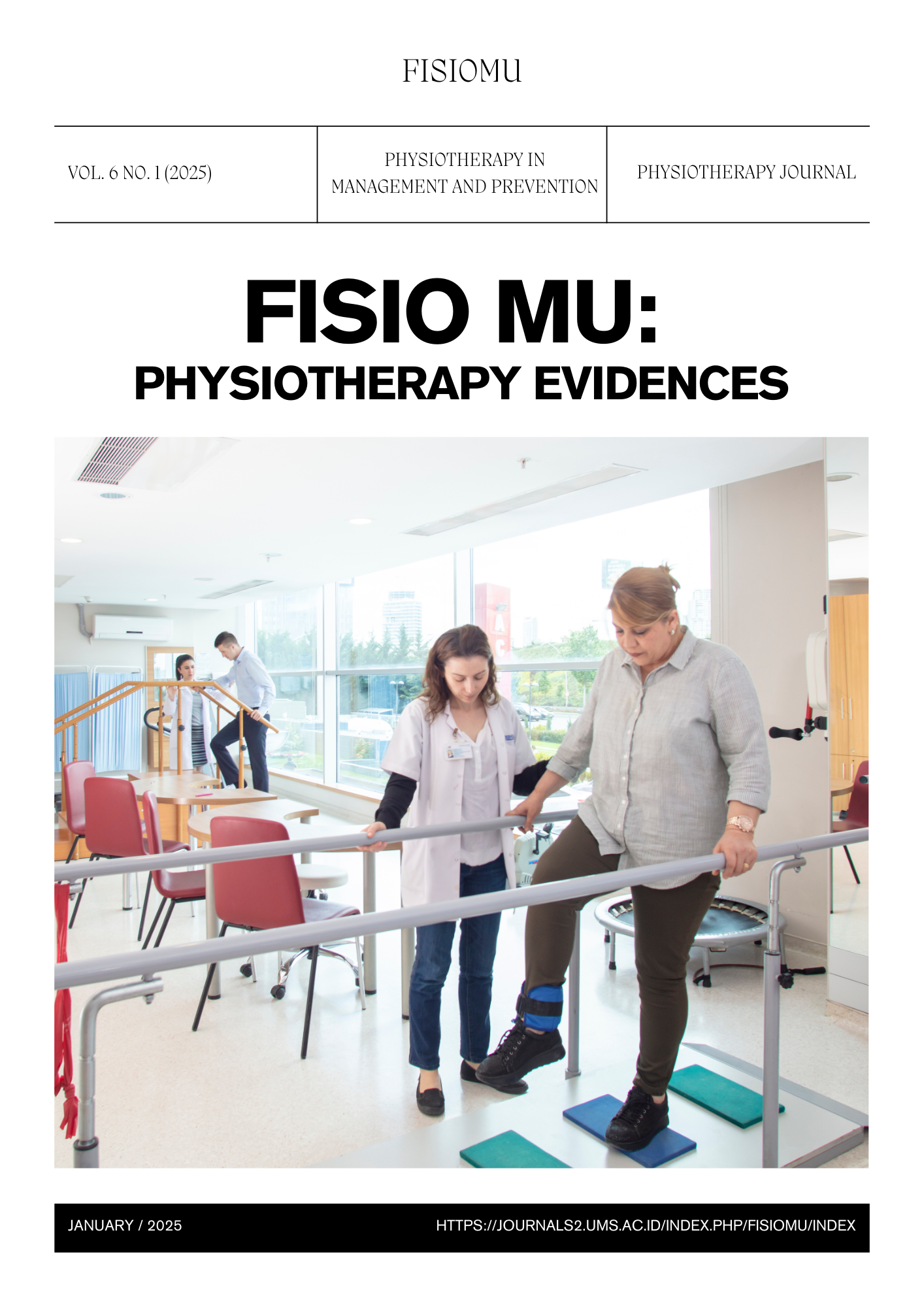The Relationship Between The Degree Of Arcus Pedis And The Degree Of Vertebral Curve In Children
DOI:
https://doi.org/10.23917/fisiomu.v6i1.7699Keywords:
Arcus pedis, Vertebral Curv, Posture, Clarke's Angle, ScoliometerAbstract
Background: Spinal health is the most important part of a child's body posture. Age 2-6 years is a period of rapid growth and during this period the vertebral curve will develop rapidly too. The greater the degree of lateral vertebral curve, the more it will result in a posture abnormality called scoliosis. One of the factors that influences body posture abnormalities is the degree of arcus pedis, which normally forms in the first five years of development in children aged 2-6 years. The degree of the vertebral curve can be measured using a scoliometer and the degree of the arcus pedis using the footprint test (Clarke's Angle). This research aims to see whether there is a relationship between the degree of Arcus pedis and the degree of vertebral curve in children 4-6 years old in the Kartasura area. Methods: This research is quantitative research with research methods using univariate analysis, data normality and bivariate. The number of respondents was 565, and the method used was purposive sampling with inclusion, exclusion and dropout criteria. Results: The results of the correlation test using the Nonparametric Correlation Test with the Spearman Rank Test show that there is no relationship between the degree of the Arcus pedis and the degree of the vertebra with a p-value of 0.228 (p>0.05) and the correlation level is very weak (0.051) and the direction of the relationship is positive or unidirectional. Conclusion: There is no relationship between the degree of arcus pedis and the degree of vertebral curve in children aged 4-6 years in the Kartasura area.
Downloads
References
Baswara, C. G. P. K., Weta, I. W., & Ani, L. S. (2019). Deteksi dini skoliosis di tingkat Sekolah Dasar Katolik Santo Yoseph 2. Intisari Sains Medis, 10(2), 253–257. https://doi.org/10.15562/ism.v10i2.185 DOI: https://doi.org/10.15562/ism.v10i2.185
Ismi, D., & Pasaribu, S. R. (2023). Hubungan Arcus Pedis Normal Dengan Kelincahan Motorik Pada Anak Usia Pra Sekolah Di Desa Daya Murni. Ibnu Sina: Jurnal Kedokteran Dan Kesehatan - Fakultas Kedokteran Universitas Islam Sumatera Utara, 22(1), 100–103. https://doi.org/10.30743/ibnusina.v22i1.345 DOI: https://doi.org/10.30743/ibnusina.v22i1.345
Karandagh, M. M., Balochi, R., & Soheily, S. (2015). Comparison Of Kinematic Gait Parameters In The 16-18 Years Male Students With The Flat And Normal Foot. Indian Journal of Fundamental and Applied Life Sciences, 5(S1), 5165–5172. www.cibtech.org/sp.ed/jls/2015/01/jls.htm
Ma, H. H., Tai, C. L., Chen, L. H., Niu, C. C., Chen, W. J., & Lai, P. L. (2017). Application of two-parameter scoliometer values for predicting scoliotic Cobb angle. BioMedical Engineering Online, 16(1), 1–13. https://doi.org/10.1186/s12938-017-0427-7 DOI: https://doi.org/10.1186/s12938-017-0427-7
Munawarah, S., Mardiah, A., Sari, M., Kesehatan, F., Fort, U., & Kock Bukittinggi, D. (2021). Pemeriksaan Arcus Pedis. Empowering Society Journal, 2(3), 230–235.
Muzafarovna, K. S. (2022). With Scoliosis in Children, Changes in the Morphological Parameters of the Foot. 17–23.
Nabila, E. (2020). Efektivitas Skoliometer Sebagai Alat Deteksi Dini Skoliosis. Health & Medical Journal, 2(1), 58–61. https://doi.org/10.33854/heme.v2i1.297 DOI: https://doi.org/10.33854/heme.v2i1.297
Naufal, A. F., & Wahyuni.H, N. I. (2022). Postur Abnormal dan Keseimbangan Pada Anak: Literature Study. FISIO MU: Physiotherapy Evidences, 3(2), 113–119. https://doi.org/10.23917/fisiomu.v3i2.18040 DOI: https://doi.org/10.23917/fisiomu.v3i2.18040
Paolucci, T., Pezzi, L., Mannocci, A., La Torre, G., Bellomo, R. G., & Saggini, R. (2020). Flat foot and postural harmony in 6-year-old Caucasians: What is their relationship? Annals of Rehabilitation Medicine, 44(4), 320–326. https://doi.org/10.5535/arm.19091 DOI: https://doi.org/10.5535/arm.19091
Peng, Y., Wang, S. R., Qiu, G. X., Zhang, J. G., Zhuang, Q. Y., & Wang, N. N. (2020). Research progress on the aetiology and pathogenesis of adolescent idiopathic scoliosis. Chinese Medical Journal, 133(4), 483–493. https://doi.org/10.1097/CM9.0000000000000652 DOI: https://doi.org/10.1097/CM9.0000000000000652
Pita-Fernández, S., González-Martín, C., Seoane-Pillado, T., López-Calviño, B., Pértega-Díaz, S., & Gil-Guillén, V. (2015). Validity of footprint analysis to determine flatfoot using clinical diagnosis as the gold standard in a random sample aged 40 years and older. Journal of Epidemiology, 25(2), 148–154. https://doi.org/10.2188/jea.JE20140082 DOI: https://doi.org/10.2188/jea.JE20140082
Rahman, F., Fatmarizka, T., Susilo, T. E., Fitriyah, Q. F., Lazuardy, A. A., Cahyadi, M. M., Surakarta, U. M., & Surakarta, K. (2023). Implementasi Buku Skrining dan Stimulasi Motorik kasar Anak Stunting Usia 0-60 Bulan Dalam Peningkatan Pemahaman Isu Stunting Masayarakt di Desa Mancasan. 5(4). DOI: https://doi.org/10.57214/pengabmas.v5i4.405
Romanova, E., Kolokoltsev, M., Vorozheikin, A., Baatar, B., Khusman, O., Purevdorj, D., Garov, S., Starshova, N., & Kiseliv, Y. (2022). A comprehensive program for flat foot and posture disorders prevention using physical education in 6-year-old children. Journal of Physical Education and Sport, 22(11), 2655–2662. https://doi.org/10.7752/jpes.2022.11337 DOI: https://doi.org/10.7752/jpes.2022.11337
Sengkey, L. S. (2016). Deteksi dini skoliosis menggunakan skoliometer pada siswa kelas VI SD di Kecamatan Mapanget Manado. 4(April). DOI: https://doi.org/10.35790/ecl.4.1.2016.10831
Setiawan, C., Griadhi, I. P. A., & Primayanti, I. D. A. I. D. (2021). Gambaran Postur dan Karakteristiknya pada Mahasiswa Kedokteran Umum. Jurnal Medika Udayana, 10(4), 13–22. DOI: https://doi.org/10.24843/MU.2021.V10.i4.P03
Syabariyah, S., Anesti, R., & Alfin, R. (2022). Kemaknaan Lengkung Kurvatura dan Rib Hump pada Skrining Risiko Skoliosis. Buletin Ilmu Kebidanan Dan Keperawatan, 1(02), 53–62. https://doi.org/10.56741/bikk.v1i02.125 DOI: https://doi.org/10.56741/bikk.v1i02.125
Varani, dr. R. (2022). Mengenal Skoliosis Dan Terapinya. 4–15.
Zaharieva, D. (2014). Flat feet, prone feet, posture and dependency between them in first-grade children. Scoliosis, 9(S1), 2014. https://doi.org/10.1186/1748-7161-9-s1-o16 DOI: https://doi.org/10.1186/1748-7161-9-S1-O16
KEPMENKES RI.(2021).Pedoman Nasional Pelayanan Kedokteran Tata Laksana Skoliosis Idiopatik Remaja. Diakses Dari: https://yankes.kemkes.go.id/unduhan/fileunduhan_1681540122_789702.pdf
Yueniwati, Y. (2014). Prosedur Pemeriksaan Radiologi Untuk Mendeteksi Kelainan Dan Cedera Tulang Belakang. Universiras Brawijaya Press
Downloads
Submitted
Accepted
Published
How to Cite
Issue
Section
License
Copyright (c) 2024 Fisio Mu : Physiotherapy Evidaces Journal

This work is licensed under a Creative Commons Attribution-NonCommercial-NoDerivatives 4.0 International License.

This work is licensed under a Creative Commons Attribution-NonCommercial 4.0 International License.
Authors who publish with FISIO MU: Phsiotherapy Evidences agree to the following terms:
- Author(s) retain copyright and grant the journal right of first publication with the work simultaneously licensed under a Creative Commons Attribution-NonCommercial 4.0 International License that allow others to share the work within an acknowledgement of the work’s authorship and initial publication of this journal.
- Author(s) are able to enter into separate, additional contractual arrangement for the non-exclusive distribution of the the journal’s published version of the work (e.g. acknowledgement of its initial publication in this journal).
- Author(s) are permitted and encouraged to post their work online (e.g. in institutional repositories or on their websites) prior to and during the submission process, as it can lead to productive exchanges, as well as earlier and greater citation of published works.












